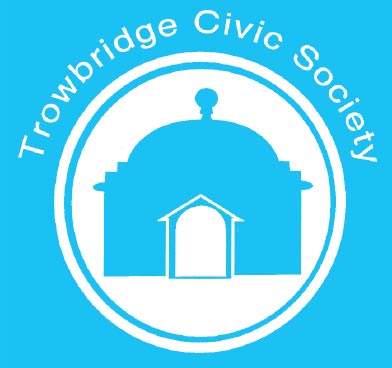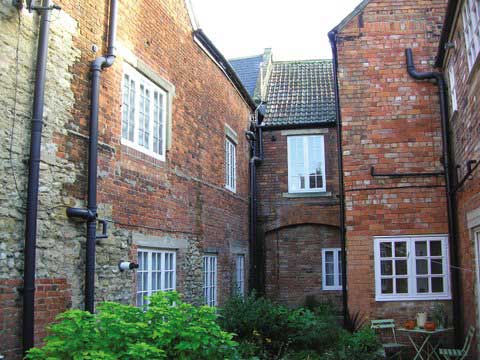| ||||||||||||||||||||||||||
Contents
Click on the item to go to the article. |
Editorial Comment
Wende's delightful contribution has an implied sting in its tail. It is a shame that some of our elected representatives care so little for our architectural heritage. The deadline for copy for the summer newsletter is Friday, 7th May - how about letters and articles? |
Forthcoming Events
| 2010 | ||
| Tuesday 16th March 19:15 |
Annual General Meeting followed by a talk by Ken Rogers - The Manorial Lords of Trowbridge. |
Manvers Hall, United Church, Church Street, Trowbridge. |
| Tuesday 27th April 14:30 |
An afternoon guided walk of Frome by Alistair McLeay |
Meet at the TIC next to the old cattle market. £2 per head in aid of Frome Museum. |
| Thursday 20th May 19:00 |
Guided walk around Trowbridge with Midsomer Norton Society members |
Meet at 7 pm at St James' Church. |
| Tuesday 1st June | Outing and tour of the Houses of Parliament | see website for full details |
| The full 2010/2011 programme will be issued shortly | ||
From a Vice-Chairman
That's how it was for me (with apologies to Maureen Duffy)
- an aromatic journey through Trowbridge in c.1950's
In those days one could walk the whole length of Ashton Street to Polebarn Road. I lived in Fern Cottage - actually not a cottage at all but a very fine Victorian villa - at the top of the cul-de-sac, beyond which were allotment gardens. There my mother cared for teenage girls who, for a variety of reasons, could not live in their family homes. The minute you stepped outside the front door you were greeted by the heady reek from the enormous pile of hop waste at the bottom of the allotments. The smell was warm and earthy, certainly not unpleasant, and its source must have worked well as a fertiliser because the crops were always spectacular. I can certainly vouch for the succulent and fragrant strawberries - they were well worth the punishment we received when we were caught red-handed - literally!
Crossing Polebarn Road, which then ran all the way to West Ashton Crossroads, and past Courtfield House and Courts Mill (although we always called the factories by their owners' names, in this case it was Palmer Mackay's) you breathed in an ineffable aroma; a blend of engine oil and a steamy sweetish, musky smell which I later discovered was the lanolin from the wool. Beyond the Park lay St Stephen's Place to the right of which, on Tuesdays, the cattle market brought a strong, unmistakeable whiff of farmyard animals. I never did see farmers in smocks, more's the pity, but they did Look fine in their gaiters and tweeds. Turning left into Castle Street and past McCall's factory, or Upper Mills to be posh, (that woollen mill smell again); over Cradle Bridge into Mortimer Street you passed, on the left, Longfield House with its venerable Horse Chestnut tree, with a candelabra of heavenly perfumed blossoms in May, standing guard behind a high stone wall. Right then into Bythesea Road, where Cases, the pork butcher, made the best bacon and sausages on earth; you would know where you were with your eyes closed Next the impressive statement to municipal pride that was County Hall, which was then symmetrically flanked on either side by twin lodges, rising above a large expanse of lawn and sentinel plane trees. Then came the grand Regal Cinema (where I saw many an illegal free film), the Wilts United Dairies on the left, opposite the not-so-grand Focus Cinema (the flea pit to us). Crossing Stallard Street the whiff of pies from Bowyers heralded the entrance to the railway station where I caught my train to Bath, and the school I attended for the first year of my life in Trowbridge.
Trowbridge then had a proper station, with magazine stall, caf&eacut;, toilets and on platform 1 and between platforms 2 and 3 there were large waiting rooms, with benches upholstered in leather along the walls, and a real fireplace. On chilly winter mornings, the red-hot fume of a coal fire hit the nostrils and soon warmed frozen fingers and toes, whilst we schoolchildren played shove ha'penny on the huge table at centre stage until tremors under the feet heralded the arrival of our train in clouds of pungent, steamy smoke. After that first year I was taught by the Sisters of St John of God at their convent school for girls on the corner of the Wingfield and Avenue Roads, later moving with the school along the road to a lovely Victorian house; Dulce Domum. Set in its own extensive grounds including an orchard, the school was neighbour to farmland, the home of beautiful, lustrous-eyed Guernsey cows, owned by Westfield Farm where I lived for a time when my mother was away studying the latest theories in childcare at Rolle College in Exeter. I can vouch that porridge (or cornflakes) for breakfast, with thick, honey-coloured Guernsey cream and topped with demerara sugar is delicious beyond description. The journey to school became a bicycle ride: cycling was forbidden in the park but you could dismount and ‘scoot’ on one pedal, watching carefully for park attendants, across the part adjacent to the Bowling Green which was fenced and partly lined with shrubs. Or you could take an alternative route by turning right out of Ashton Street to the top of Polebarn Road and left into Roundstone Street where your nose could follow a sugary trail up an alley on the right to beg for rosebuds or humbugs at the sweet factory. This continued into Duke Street where the acrid smelt of printers ink from the Wiltshire Times presses lingered even on non-printing days. Finally, past the noble and inspiring Parish Church of St. James, and the Tabernacle Church with its attendant houses in the eponymous Church Street to Back Street, and there with the malty, hoppy scent of Ushers Brewery, the journey now ends. None of these wonderful, evocative aromas exist any more in Trowbridge but they remain a valued memory of my teenage years.
Trowbridge has had many incarnations as it evolved from a small settlement by the Biss to be augmented by a great castle, defended in part by that same river, and around which the bustling market town grew. The castle was lost but the surrounding rich clay lands produced fodder for sheep and the town became the centre of a prosperous woollen industry. From work in the home with hand loom and spindle in second floor weavers' attics in Yerbury Street, Waldron Square and Newtown, through water power to magnificent steam-driven factories with attendant service industries of engineering expertise, Trowbridge flowered and prospered. Rapid expansion took place with the building of modest homes for workers, grand villas for their employers, schools and churches of many denominations. Shops evolved into large department stores providing clothing and all household necessities. Pork butchers and pie-makers grew into food factories and one entrepreneur brewer expanded with a purpose-built brewery to supply his many inns and succour his hard-working customers. The stately, utterly unique and truly wonderful Town Hall, so aptly expressing the exuberant confidence of the late Cl9th, was built and given to the people of Trowbridge by Sir Roger Brown, who also set up a subscription for the purpose of acquiring the land behind for a Peoples Park. The Market House commemorating the Lord of the Manor, William Stancomb, was also built. These two dignified and complementary edifices proudly hold centre stage in the town, monuments to a time when townsfolk were justly proud of their great heritage.
Planning Matters
For once I do not have any bad news! The applications for the Waterside Development and for Wiltshire College relocation to the former Bowyers site have both been formally withdrawn. The process of seeking a developer for the land between old Tesco and Asda has started. Wiltshire Council has agreed that Adam Nardell will be responsible just for Trowbridge, and another appointment will be made for redevelopment in Chippenham. That is good news! The Transforming Trowbridge Group has been resurrected and is now meeting regularly. Wiltshire College is looking at a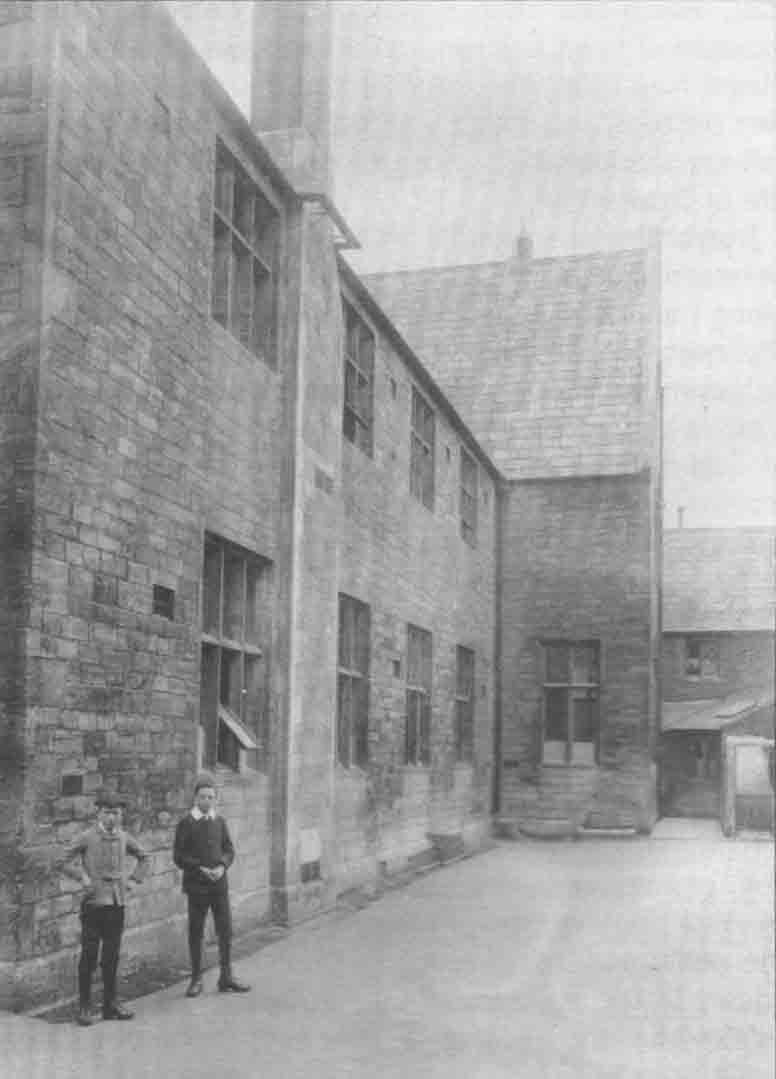 more modest development on their present site. The application to redevelop the Rose and Crown, Stallard Street, has also been withdrawn, and it is for sale for “refurbishment or conversion”. One wonders how long it will remain empty, boarded up, and becoming increasingly dilapidated. The Kingdom Life Church who meet in Park Hall, Frome Road, has approval for partial change of use, to provide a temporary overnight winter shelter for people referred by Alabare. Terry's Social Club in Hill Street has approval for conversion to residential use, mainly one bed flats, of which there is a known shortage. The main feature of interest, the staircase, will not be affected. Work can be seen progressing on the former Ushers bottling site and the developers have permission to form a 4-armed roundabout opposite the Margaret Stancomb building. This includes removal of part of the wall and railings. The Town Council has approval for partial demolition, rebuilding and extension of the Civic Hall.
more modest development on their present site. The application to redevelop the Rose and Crown, Stallard Street, has also been withdrawn, and it is for sale for “refurbishment or conversion”. One wonders how long it will remain empty, boarded up, and becoming increasingly dilapidated. The Kingdom Life Church who meet in Park Hall, Frome Road, has approval for partial change of use, to provide a temporary overnight winter shelter for people referred by Alabare. Terry's Social Club in Hill Street has approval for conversion to residential use, mainly one bed flats, of which there is a known shortage. The main feature of interest, the staircase, will not be affected. Work can be seen progressing on the former Ushers bottling site and the developers have permission to form a 4-armed roundabout opposite the Margaret Stancomb building. This includes removal of part of the wall and railings. The Town Council has approval for partial demolition, rebuilding and extension of the Civic Hall.
More good news is that in the last published list, only 3 of the 50 decisions refer to applications lodged before November 2009. This is a great improvement, even allowing for the fact that there have not been as many applications, due to the recession.
Welcome to the following new members
Mr A. Ingham; Mr & Mrs G Payne; Mr & Mrs Shave; Mr D Shrapnell; The Trowbridge Museum.
Researching the Parochial School Archive
Interview with Mr Clarence Tadd 1977
Mr Tadd (Sept 1905 - Feb 1983) was an electrician and ran his own business in Trowbridge. He started school
when he was two, at Newtown School but later transferred to Parochial and left school in 1918.
My father was keen on me becoming an electrician as he asked Mr Pearson if he had any vacancies. Mr Pearson told him one occurred every 5 years or so but as it happened there was one at that time. I was thirteen at the time and I took the ‘Labour Exam’. If you passed this exam you could leave school at the end of the week in which you had your thirteenth birthday. The day after I took the exam twenty children had the flu and the whole school was given a month's holiday. I had to go to the rector's house to collect my certificate. Mr. Hoskins saw the rector and he gave me a reference. A leaving certificate was given to boys who were 14 and they left at the end of the week in which they were 14. Farmers' boys would be kept at home for a fortnight before their 14th birthday to help on the farms. Mr Hoskins used to get very annoyed about this but it was not worth taking them to court for not attending school. Children attended the Infant School from the age of three years until they were about seven when the girls went upstairs and the boys went downstairs. Mr Sam Belcher was the cleaner of the Girls' and Boys' Schools. I remember Mr Belcher came in one afternoon and said that Lord Kitchener had drowned on his way to Russia. There was a Trowbridge boy on the boat, I think his name was Birstow and he had a brother living in Trowbridge now. He told us that the boat, HMS Hampshire was torpedoed or struck a mine. He was on the deck with the rest of the crew when the order was given to make way for Lord Kitchener, and that was the last that was seen of Lord Kitchener. HMS Hampshire was sunk by a German mine off the coast of Orkney on 5th June 1916 with the loss of 643 lives, including Lord Kitchener. One of the few survivors was Horace Llewellyn Buerdshell of Holt.
Mr. Urban Smith was the assistant headmaster. He taught my father. My father left school at the age of ten. Mr. Urban Smith taught for 50 years. He was a Bradford-on-Avon man and he used to walk to and from school. He must have begun teaching about 1870 and it was to his credit that evening school started. He told me that boys should leave at the age of ten and then they could go on to evening education. They taught boys by day and their fathers by night. He became the organising headmaster for all Trowbridge, The British School and Trinity School. He was in charge of all evening classes at these schools. In 1881 he was living with his parents at Sladesbrook and by 1901 he was married to Evelyn, had two sons and was living in Westbourne Gardens.
Mr. Hoskins came in 1900. The rest of his family emigrated to Australia. The school garden is now known as Palmer Gardens. It was given to the County Council by General Palmer so that boys from Adcroft, Parochial, Trinity and Newtown Schools could learn gardening. We used to have a religious examination once a year. This was done by the Minister who would come and take each class. Once a year we used to go to the Parish Church for a service and on Empire Day we all used to assemble in the playground. Bob Mores, an old Sergeant Major would stand on a chair and play ‘God save the King’. I was four years in the Infant School. The infant School was right at the back of the building. One classroom was reached by a pine staircase. Doors divided us from the senior class. The girls went out to play through a door on the right and the boys through a door on the left. My brother passed to go to the High School. The Governors were men who were ‘big shots’ of the High School and were called managers. At Christmas we all had a bag of nuts and an orange. The Managers provided the money. During the first war several boys went on strike. There were about twenty boys involved. They went on strike because they thought teachers should not get so much money and the cane should be thrown away. Boys from the British School also went on strike. I have seen boys come to school without any shoes. The school used to check the weight of the children. Miss Whitmarsh, headmistress of the Infant School, had a brother who had a shoe shop in Church Walk. Out of her own pocket Miss Whitmarsh bought several pairs of shoes which she gave to children who hadn't any. The shoes were probably provided from ‘The Shoe Fund’, a charity which existed still in the 1960s but was wound up and merged with other charities when it was no longer needed as all children came to school with shoes, not always the most suitable, but they were all shod.
Extracts from the School Log Books 1911 to 1921
I have used extracts from this period which covers the time Clarence Tadd was at Parochial School and short extracts from the years after.
1911
3rd Apr: This was the beginning of the school year. 147 on the register.Staff: Hoskins HI Certificated, Head,
Smith U Uncertificated, Newman FE Certificated, Dart Al Uncertificated, Butcher AG Certificated.
18th July: Start of examinations - Reading, Composition, Spelling, Dictation, Penmanship, Arithmetic-mental
and written.
14th Sept: 12 boys absent this afternoon on what they term ‘a strike’. A Letter was sent to the parent of each boy informing him of the fact H.M.I. visited schooL and discussed new timetable. Attendance Officer also visited at 3.45.
15th Sept: Attendance Officer visited at 9.45 all ‘strikers’ were present this morning with the exception of T Allsworth.
10th Oct: Distributed one dozen toothbrushes bought by certain boys at 3d each also to each boy a small quantity of prepared chalk.
9th Nov: Temperance Address by Mr Adkins from the Band of Hope Union on eating and drinking.
4th Dec: All boys on the register weighed and measured.
21 Dec: Broke up - all boys given an orange, nuts, sweets and a bun. The pattern of the year continued in this way with much concern for the boys' health and moral fibre with lectures by worthies. Weighing and measuring was carried out twice a year. Canings by the headmaster were recorded and usually consisted of 3 cuts to the hand.
1912
18th Jan: Heavy fall of snow - over a foot. 50 boys sent home and 47 retained till noon.
20th March: School examined in Religious Knowledge by Rev E P Knubbly of Steeple Ashton. The examiner came
from a different church every year.
26th March: Examination for Labour Certificate. Also taken in November each year.
26th April: Collected for Titanic, Boys £1 0s 0d, Girls 12s 10d, Infants 5s 3d total £1 18s 1d.
9th Oct: Dr J Pearce inspected the offices (toilets) this morning.
1913
19th March: Centenary of the birth of David Livingstone. The rector gave an address to boys and a few girls.
6th May: School closed at 3.30 so that boys could visit Wombwell's and Bostock's Menagerie. The menagerie did not turn up due to a mishap at Calne.
16th June: Two teachers short. The problem of a shortage of teachers for the boys' school continued until the end of the war. Sometimes teachers were borrowed from the girls' school or women teachers were employed for a short time. At one time in 1916 with 159 boys on role there were only 3 teachers.
30th Oct: Rector visited and gave out prizes for growing hyacinth and narcissus bulbs under Trowbridge Floricultural Society. Silver medal for best bulb grown in the district was given to Victor Holland.
14th Nov: Dr Steele visited in the afternoon and extracted teeth from 5 boys.
1914
8th July: Sent 49 boys to the Picture Palace to view ‘Sixty Years a Queen’. Boys are there by kind permission of Mr Albany Ward.
31st Aug: Mr S Farmer absent doing duty for his country with the Territorials. From 16th Oct until 23rd Dec the boys school sent £1 5s 3d to the Weekly Despatch Fund to provide comforts for our troops. This money provided 1630 cigarettes, 6lbs 12 ozs tobacco and 50 packets of matches.
1915
11th Jan: 131 on roll. 3 teachers short. Mr S Farmer is with the colours in India, Mr F E Newman joined up.
30th Aug: Re-opened school - 137 attended out of 149 due to whooping cough.
29th Oct: Half holiday. Egg Day - the boys brought 75 eggs for wounded soldiers.
1916
17th Jan: 8 boys were punished for truanting last Friday afternoon. They absented themselves when sent by their parents to witness a military funeral. Each received 2 strokes on each hand.
29th Feb: Fresh fall of snow. 8 measles contacts away besides those absent due to the snow. During March there was more snow and the attendance for the whole month was poor due to sickness. When children were in contact with diseases like measles they had to stay at home until the family was clear of the disease.
11th May: No school this afternoon. The few boys present - about 20 at 1.55 - were sent home by order of the rector. The playground and the lavatories are used by the militia. 5,000 troops from Devizes marched into the town during the dinner hour. They are billeted in the town for the night.
10th July: Exams started. Made a collection from staff and boys for children in Belgium 17s 2d.
14th Sept: Several boys absent as there is a circus in town.
21st Sept: Made a collection for John Travers Cornwell Memorial from staff and boys £1 . “Jack” Cornwell enlisted when 15, he was a gun sight setter at the Battle of Jutland aboard HMS Chester. On 31st May four German warships attacked the ship. All his gun crew were killed except Jack who, though severely wounded, remained standing at his post until his ship retired from action. He died on June 2nd at Grimsby Hospital and was posthumously awarded the VC.
20th Dec: The rector gave an address on War Savings to boys and oLder girls. Parents invited but not one turned up.
21st Dec: Snow falling heavily. Comforts for Tommy at the Front from Oct 14th £11 8s 6d. This was a very difficult year with only 3 teachers for the boys' school. Discipline must have been more difficult to maintain as there are more recordings of punishments than for previous years.
1917
23rd Jan: The rector visited and unveiled a picture of Jack Cornwell and afterwards gave an address to the boys. 30 elder girls were present. The Court Painter, Frank 0 Salisbury, was commissioned and used Jack's elder brother as a model. The portrait is now at HMS Raleigh near Plymouth.
2nd April: 5 cases of measles and other cases of sickness. Fall of snow.
27th April: Cases of chicken pox and measles reported. This date started further outbreaks of measles, mumps, chicken pox and sickness which continued until 6th July when the last 2 cases were reported.
28th Sept: A large number of chestnuts were collected by the boys and sent to the depot this week (about 15 sacks). Horse chestnuts were used to make acetone, for the production of cordite.
18th Oct & 22nd Oct: Half day holiday for blackberry picking. 41 lbs & 64 lbs.
5th Nov: Half day given for gathering acorns.
9th Nov: Visit to Trowbridge of the King and Queen. Children assembled in Wingfield Road to see their majesties.
1918
14th Jan: Fall of snow, the first this winter. Snow fell during the first half of January and on 16th it was reported that the river was in flood.
24th June: The screens came today and were put into position. Were these the partitions between the classrooms which were still there when the school closed in 1967?
14th Oct: Miss Ponting absent this morning owing to the loss of her brother on the Western Front.
30th Oct: School closed by order of the MOH through the influenza epidemic until Tuesday 5th November.
19th Dec: Broke up for the Christmas Holiday. Each boy was given 2 buns. This must have been a lean year, as the usual treats of sweets, nuts and fruit were missing.
1919
20th Mar: A man called Frank Smith came into the school this afternoon and created a great disturbance. He threatened the headmaster. His language was filthy and disgusting. He refused to leave when asked to do so. When he did leave he took his brother R Smith with him.
24th Mar: The Children's Newspaper was publicised to the boys. 28 boys gave in their names as regular subscribers and paid for their first copy. The first issue was printed 22nd March 1911 at the cost of penny half- penny. It ran until 1965 when it merged with ‘Look and Learn’.
1920
22nd Oct: Organized games are beginning from today. 24 boys taken to Court Fields by Mr Newman for football.
11th Nov: 2nd anniversary of Armistice Day and 12 boys were present in The Peoples Park at 10.30 am. Four had lost their father in the Great War and eight a brother.
1921
11th Jan: 32 boys were sent to the parish Church to receive an address from the rector on the new Memorial Window which was unveiled on Sunday 9th Jan.
11th Nov: Many boys came with a Flanders Poppy in their coat. Been a very cold week with snow and a hard frost. During this period the number of boys in the school was between 140 and 150 but reached a peak of 160 after the war. The school constantly struggled to have enough staff. Before the war there were 5 members of staff but after only 4. In 1920 Miss Ponting left to get married with a suitable gift presented by the rector. Mr Newman left the following year and was presented with a silver cigarette case. A government inspection report in Feb 1921 stated that only Class 1 was satisfactory. The boys were noisy and in the higher classes spelling and expression, both written and oral, was not satisfactory. On the whole this was not a favourable report. On 11th July a new master, Mr R E Noise was appointed!!
Trowbridge Civic Society School Awards 2009
Congratulations to the following recipients:
| Clarendon College | Callum Hatch | History |
| John of Gaunt | Frances Skinner | History |
| St Augustines' | Sophie Upton | Athletics* |
I was there
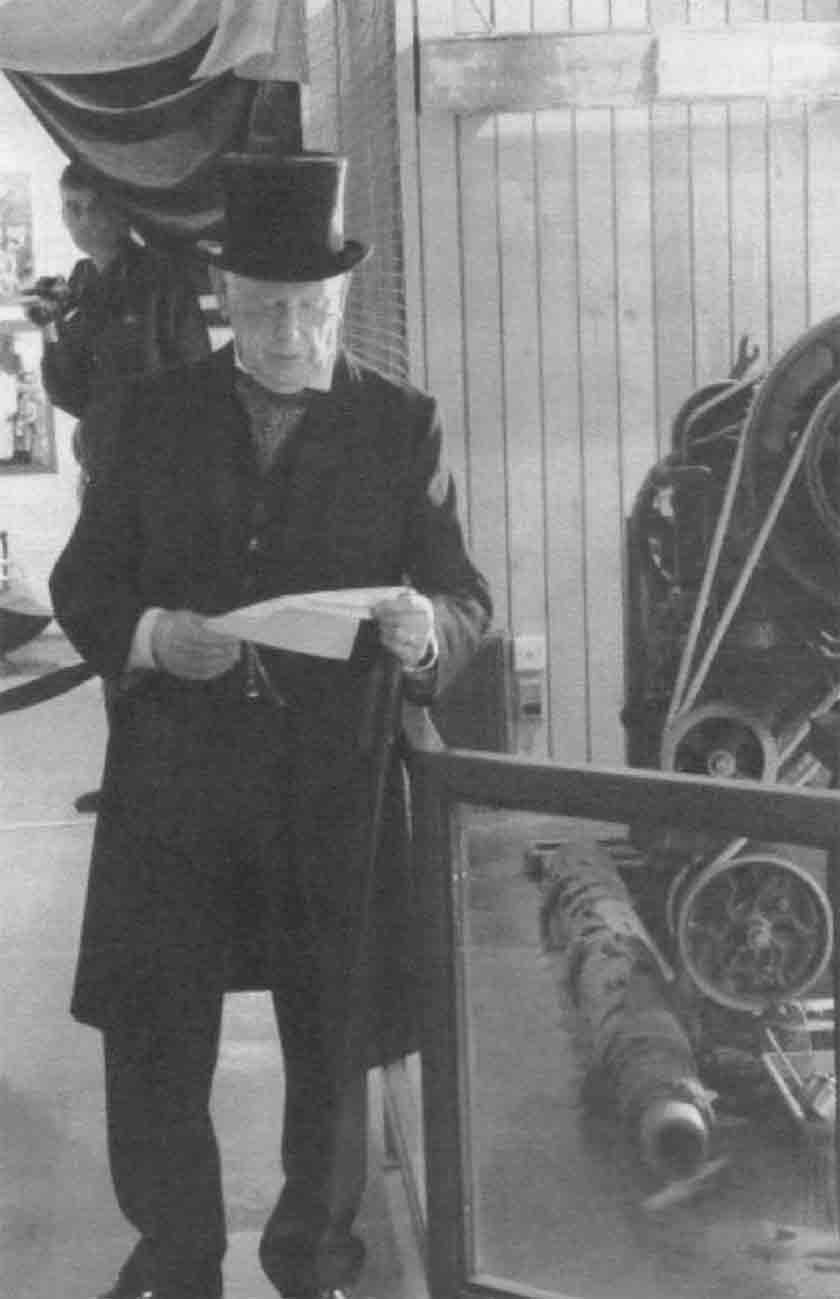 On Saturday November 28th the Trowbridge Museum opened a new exhibition depicting the Victorian era, which we all know was a period covering some 64 years (1837-1901). Just before you enter the gallery you wiLt see a lovely decoupage VICTORIAN TROWBRIDGE. As you enter the exhibition you are immediately stepping back in time and a sharp contrast between the rich and the poor is shown by the wall covering, the rich with their beautifuLLy designed wallpaper, the poor by the newspaper stuck on to cover the cracks in the plaster. Let us now Look at the exhibits where all aspects are shown starting with a beautiful 18th century smock, proceeding on there are displays of pottery, tradesmen's tools, photographic equipment, medical supplies (Aptins photograph) etc. Not to be missed is the show case showing some very fine examples of Victorian needle and crochet work. All Life in Victorian times is covered on descriptive panels including Life and Death, Christian Duty, Religions, Schooling and various trades in the town. To keep the interest of the children a wooden jigsaw is available for them to make up a Victorian picture. An excellent publication has been produced to accompany this exhibition which explains Victorian Life in more detail and is available in the shop priced at £3.50. Why was I there? I had the honour of officially opening this exhibition and to thank the Curator, staff and friends of the Museum for putting on a wonderful exhibition which lasts until April 24th.
On Saturday November 28th the Trowbridge Museum opened a new exhibition depicting the Victorian era, which we all know was a period covering some 64 years (1837-1901). Just before you enter the gallery you wiLt see a lovely decoupage VICTORIAN TROWBRIDGE. As you enter the exhibition you are immediately stepping back in time and a sharp contrast between the rich and the poor is shown by the wall covering, the rich with their beautifuLLy designed wallpaper, the poor by the newspaper stuck on to cover the cracks in the plaster. Let us now Look at the exhibits where all aspects are shown starting with a beautiful 18th century smock, proceeding on there are displays of pottery, tradesmen's tools, photographic equipment, medical supplies (Aptins photograph) etc. Not to be missed is the show case showing some very fine examples of Victorian needle and crochet work. All Life in Victorian times is covered on descriptive panels including Life and Death, Christian Duty, Religions, Schooling and various trades in the town. To keep the interest of the children a wooden jigsaw is available for them to make up a Victorian picture. An excellent publication has been produced to accompany this exhibition which explains Victorian Life in more detail and is available in the shop priced at £3.50. Why was I there? I had the honour of officially opening this exhibition and to thank the Curator, staff and friends of the Museum for putting on a wonderful exhibition which lasts until April 24th.
PS: We are delighted to welcome The Trowbridge Museum as a corporate member
Book Review
‘Trowbridge Through Time’ by Kevin Hartley and Andrew Jones
Amberly Publishing have used the always fascinating ploy of ‘then and now’ photographs, as regularly featured in The Wiltshire Times. Society members Kevin and Andrew have produced over 90 pairs of images of buidings and street scenes. The ‘new’ images are contemporary (the book was published last year) and the ‘then’ pictures are mostly from the latter half of the last century and thus well within the memory of most of us. The changes shown are very significant and show some sad losses but also some worthy gains. The only disappointment is that there are not more pairs of pictures - apparently an editorial constraint was imposed by the publisher. Trowbridge Through Time is available from Trowbridge Museum shop and other outlets at £12.99.
Unsung heroes of the Society
A big thank you is due to those members who do not serve on the committee, but are invaluable behind the scenes. I refer to those who deliver the newsletter and other notes and to those who help with the meetings and outings. On behalf of the committee I should Like to thank Paul Lamb, for without his skill on the computer the newsletter would be a shadow of what we produce today. To the deliverers - Daphne Peat, Edna Matthews, Barbara King, Bob Hallam, David Saxby, Harry & Maureen Futcher and Ann Beard, well done all of you. A big thank you also to Ruth Bridges for the refreshments at the indoor meetings, especially the homemade biscuits, and to those who help at Heritage Open Day and support us with raffle prizes and turn up early to help set up the meeting room.
If you would like to help the society but feel you do not wish to commit to being on the committee we would love to hear from you, we have many ideas which require help! However if you are willing to join our friendly committee we wouLd like to hear from you as well. In either case please contact Glyn on 755784.
The West Side of Hill Street
Few of us ever walk along Hill Street, and fewer still penetrate the area behind the buildings on its west side, so that we do not see some of the best examples of restoration of old buildings done in Trowbridge in recent years. Only two of these show distinguished facades on the street frontage, No 12 at the right hand (Shails Lane) end, and Kitchener Court at the left hand (Town Bridge) end. Between these are four sites with little to attract attention on the street side. The details of the ownership of all these sites can be traced from the 16th century or before, and will make a Trowbridge History article in due course; two belonged to James Terumber and formed part of the endowment of his chantry in the parish church in 1483; two others were held under the manor of Trowbridge Dauntsey, and one under the manor of Trowbridge Ashley. No 12, however was an ancient freehold; in the 17th century it was occupied by a succession of tanners, but from about 1720 it was owned and occupied by a family of clothiers and dyers called Whitaker. The stone frontage, facing up Back Street, appears to date from the early 19th century, as do the handsome iron railings, but the rear elevation of brick suggests that the house is older. Behind is the finest and most extensive range of 18th century clothiers' workshops in the town. These remained in use in the clothing business until the middle of the 19th century; later they were used by Colliers, cloth merchants, Ushers for stores, and Ladds the builders' merchants.
Some years ago the whole group of buildings was taken over for development as ‘The Trowbridge Leisure Complex’, advertised as a private members club for all the family. A great deal of money was expended on fitting up a bar and other amenities, but the project evidently came to grief. Glyn Bridges and I were asked to look at the place; roofs had leaked and windows had been left open, and we squelched along on carpets sodden with water and pigeon muck. We came away deeply depressed. Not long afterwards I began to prepare my Museum ‘yellow book’ on clothiers' workshops. I needed to revisit the site, and prepared for even more depression after further years of deterioration. I was astounded. A modern extension at the back had gone; the recent roofing over of the central part had been removed, and the whole converted into units of accommodation placed round a charming courtyard reached by an archway to the rear. This excellent work has not been limited to the workshops behind No12 - the whole group of buildings along to Kitchener Court has been restored. Their interest, not apparent from the street, is best seen from the rear. No 13 was in fact rebuilt in 1880, replacing an old house which was once the home of John Knapp, who was responsible for the establishment of the first Wesleyan Methodist chapel in town. The buildings adjoining it are far older, showing an interesting variety of brick and stone work.
A long group of buildings at right angles to the street and extending back to the river comes next. When Glyn and I 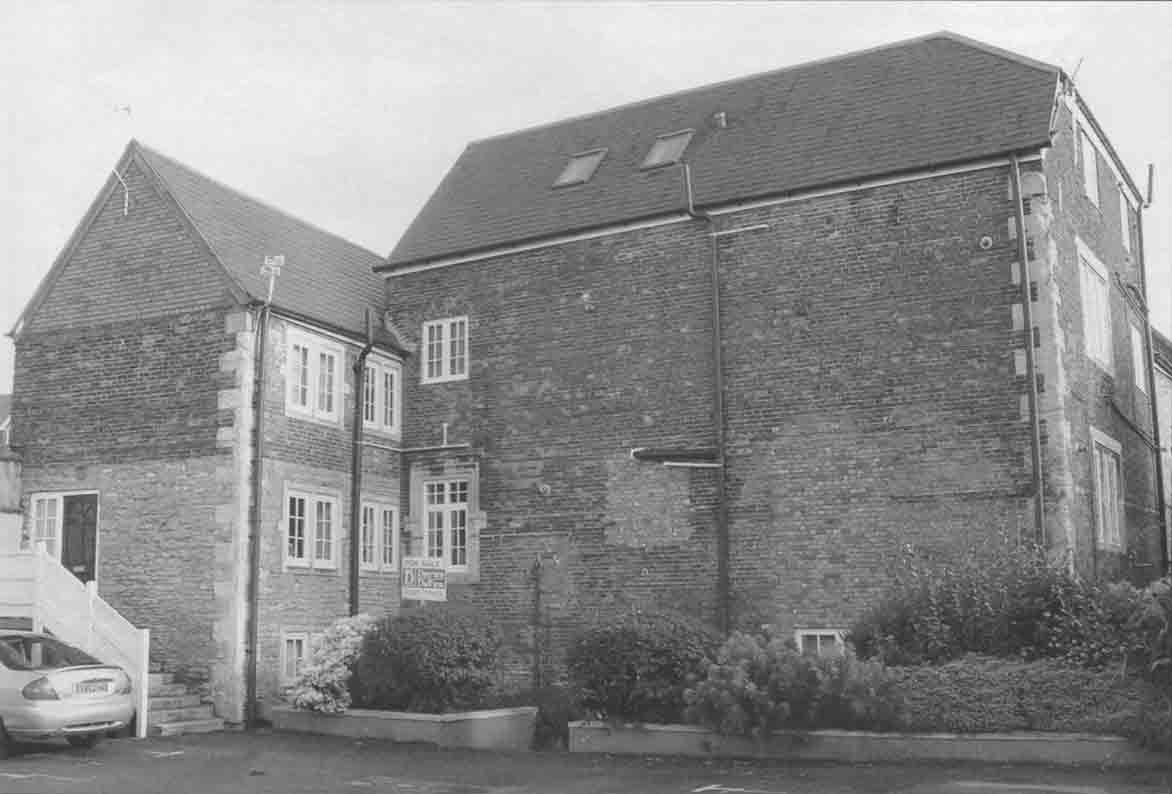
visited the site the whole was derelict. The part nearer to the street is the remaining part of a group of workshops built c1790 and subsequently converted to houses known as Naish's Yard (see Clothier's Workshops no 15). In 1864 part of the yard was demolished and replaced by a building which is described as a malthouse on 0.S. maps. It certainly has a kiln and long floors typical of a malthouse, though the documentary evidence suggests it was used for bacon curing; it was probably built so that it could be used for either purpose. What it certainly is not is an oast house, which are only found in hop-growing districts. I was showing it to a party once when a young woman came out very aggressively and told us that it was an oast house and dated from the 14th century. Both the houses and the malthouse are restored and converted to dwellings, the latter by the insertion of new windows carefully modelled on those already there.
The final building in the street, Kitchener Court, appears to have been built as a terrace of three houses, but in fact has, until its conversion to flats soon after 1980, been occupied as one public house. It dates from about 1760; the name the King of Prussia is not recorded before 1788 but must have been given at the time of the Seven Year's War (1756-63), when Frederick the Great was Britain's ally. The name was changed, for obvious reasons, to the Kitchener's Arms in 1914.
Hill Street, one little sector of our town, is now in good order on both sides. The east side links up with the Usher's Brewery restoration at one end and with The Parade at the other. The block of buildings bounded by Hill Street, Fore Street, Manvers Street, and Back Street is one of which any town might be proud, both for its historic content and for the excellent conservation by the restoration of old buildings and the erection of seemly new ones. Nearby are others that we as a Civic Society must focus on. The former Horse and Groom inn with its brewery and the adjoining warehouse at the bottom of Back Street is a group of exceptional interest. The former Town Bridge garage of 1915 is a rare survival of an early motor showroom virtually unchanged. And across the river from the back of Hill Street are the buildings of the Innox cloth mill and the handsome stone houses between the Town Bridge and the station yard which are looking so sad at present.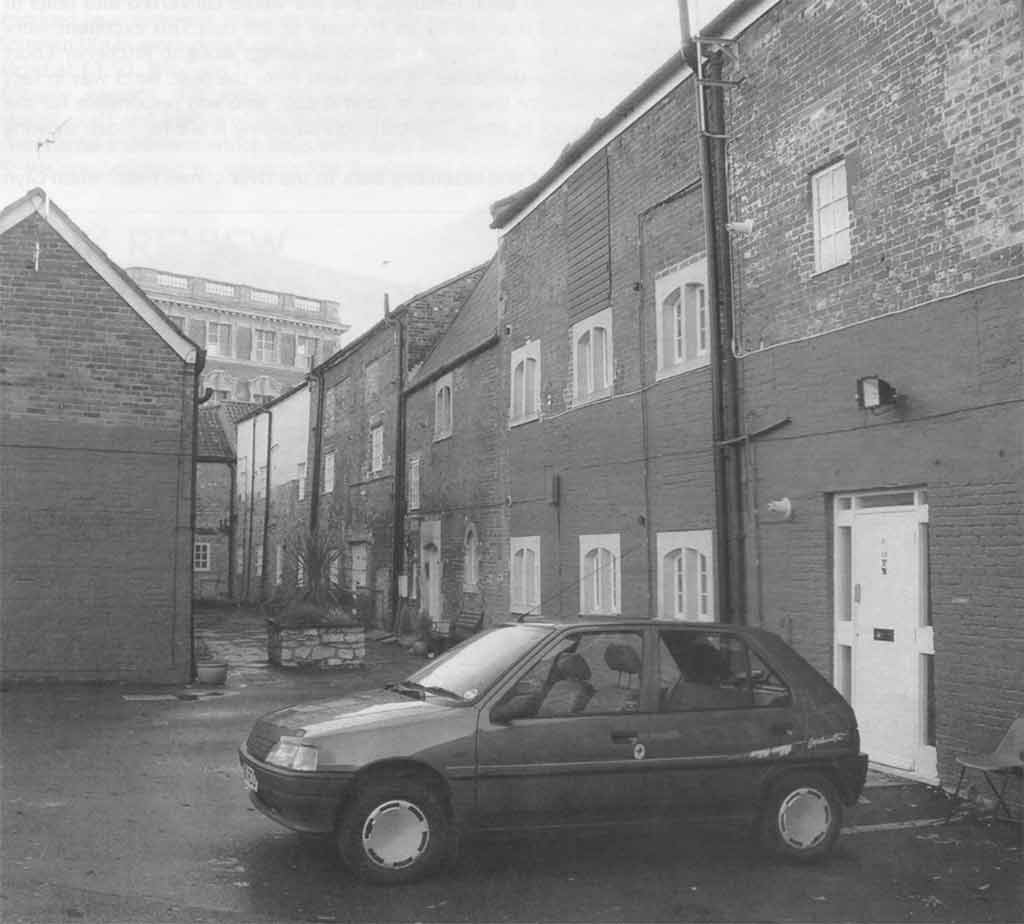
RECENT MEETINGS |
Annual Public Lecture Ken Rogers - 20th October 2009
It is always a pleasure to hear an expert talking about his own area of interest. That was the treat in store for members of the Civic Society, Friends of Trowbridge Museum and guests at this year's open lecture when Mr Ken Rogers spoke about the origins of some Wiltshire towns. Not only did we learn about some specific towns, we also enjoyed an object lesson in how the historian goes about his task establishing some kind of coherent and reliable body of knowledge.
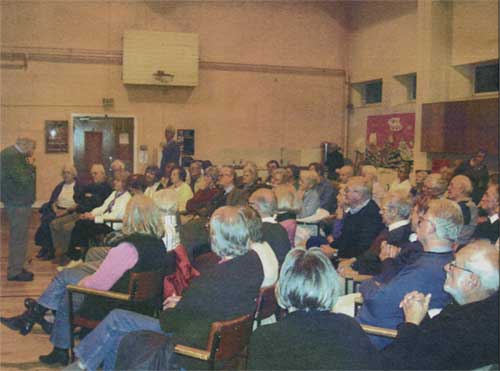 Our first example showed the marketcross at Steeple Ashton. But - what makes a town? It might have a market for which formal permission had been granted; it might have a Mayor and Corporation going back centuries; it might elect a Member of Parliament; it might have an element of formal planning. Thus Mr Rogers first established the criteria by which we consider a place a town. And in a typically quiet almost throwaway remark he revealed that the market cross at Steeple Ashton, dated 1071, was actually erected in the eighteenth century. Which led us nicely to the question of what information is available and what constitutes reliable evidence.
Our first example showed the marketcross at Steeple Ashton. But - what makes a town? It might have a market for which formal permission had been granted; it might have a Mayor and Corporation going back centuries; it might elect a Member of Parliament; it might have an element of formal planning. Thus Mr Rogers first established the criteria by which we consider a place a town. And in a typically quiet almost throwaway remark he revealed that the market cross at Steeple Ashton, dated 1071, was actually erected in the eighteenth century. Which led us nicely to the question of what information is available and what constitutes reliable evidence.
We can consult documents from earlier times. Here the Burghal Hidage and Domesday Book are significant. Ecclesiastical documents can be a good source of information on financial matters. Hindon was an interesting example; rent had previously been paid by two people using the down for agricultural purposes, when laid out as a new town with a market it brought in appreciably more income. We can look at maps from different periods, including modern ones, and we can conjecture from street layouts and street names. In all these cases we have to recognise that our knowledge is patchy, we only know what people have taken the trouble to, and been able to, find out. Excavations too may have a part to play. This was a fascinating talk, very well attended, and must have encouraged many of us to look at our local towns with renewed interest. The evening concluded informally with a raffle and refreshments.
Gone to Blazes John Craig - 17th November 2009
32 members were much amused by John&s account of his experiences as a fire chief. He recounted his career which began in 1963. He joined the Fire Services in Leicestershire, Suffolk, Sussex and finally Wiltshire. His experiences were often harrowing but in his talk he dwelt on the humorous. He recalled calling for the hydraulic shears when having to rescue a road traffic accident victim, these were known by the manufacturers name as ‘Hurst Gear’. This terrified the person being rescued who had mistakenly heard the request as a call for hearse gear! His talk had us all in fits of laughter as more and more anecdotes were remembered. Thanks to Peter Bull for running the raffle which made £19 and to Ruth Bridges for refreshments.
P.S. John Craig later pointed out that he was involved in the setting up of a sprinkler system on Studley Green estate - the first such system in Europe and has promised talk to the Society on how this came about.
| Coleman's Family Dental Practice, Timbrell Street |
| The Trowbridge Museum |
New Year Social 19th January 2010
44 members attended this meeting in the Haden Room of the United Church. The food, provided by the members, was an excellent and varied spread and much enjoyed by all. The non-alcoholic hot punch provided by Ruth Bridges was delicious and nearly everyone had a second glass. The raffle organised once again by Peter Bull raised £38, our thanks to all who took part. The Quiz was a little different this year, prepared by member Len Willis, and featured pub signs in Trowbridge, and asking us in which street they were situated. This was not as easy as it first appeared as some of the streets have been much altered in the past few years and one or two of the pubs are situated on corners or at the very end of their street and this made the quiz more tricky. There were 14 pub signs arranged around the room, it would have been 15 but one of the signs was
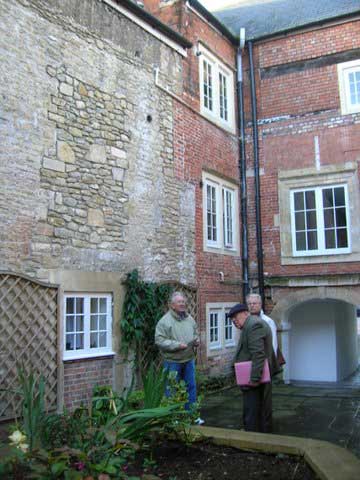 |
The items of interest brought in by some members were both varied and unusual. These included old photographs of Trowbridge streets, one a mystery street which no one has so far identified. Many old 78rpm records together with their associated paper bags from Messrs Benjamin plus one from another shop which many people did not know - Arthur Spence of Fore Street, Trowbridge - I believe that even our resident expert and President Ken Rogers had trouble with this one. The shop was on the left hand side of the present HSBC bank and Roger Newman believes it was actually on the first floor of that building. Other items included the blue striped bags provided in previous years by Knees and a very old oil can, inscribed ‘H J Knee’, a similar shape to Aladdin's lamp - reminiscent of most of our father's tool sheds, and a book of invoices and billheads dating from the early 20th century if only the prices applied today!
Our Chairman, Glyn Bridges, produced a box of puzzling objects to test our memories. Among the many items were a baby's bottle from the 1930s, a ladies hair tidy, tiny glass shades for the old wall gaslights, a spittoon, a china egg coddler, a white glass bottle with a neck at right angles which held tooth powder which could be applied efficiently to a tooth brush, curling tongs, ivory glove stretchers and the final most intriguing item of all ' a fine chain with a clip at one end and a loop at the other. No-one could identify this object and it turned out to be a device for ladies to hitch up their long skirts while out walking. The party finished about 9.3Opm and the weather was kind to us as although there was a cold wind no snow or rain spoiled the event.
Letter Boxes
Following Valerie Neighbour's piece on letter/post boxes I am sorry to report that the Post Office does not intend reinstating the Edward VII box at Islington. At present we do not know its fate.
©Trowbridge Civic Society 2010
